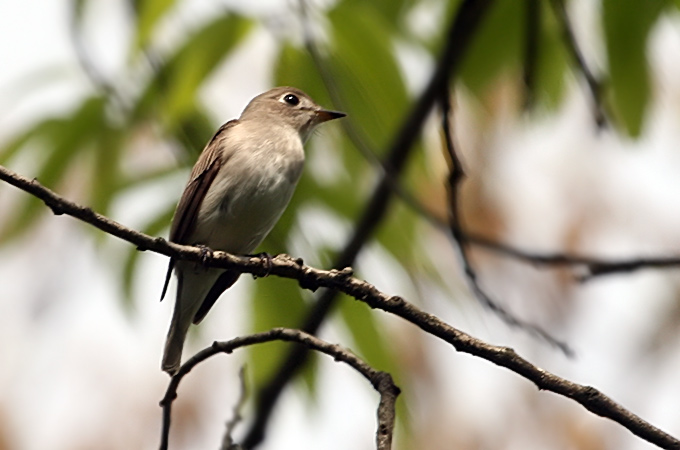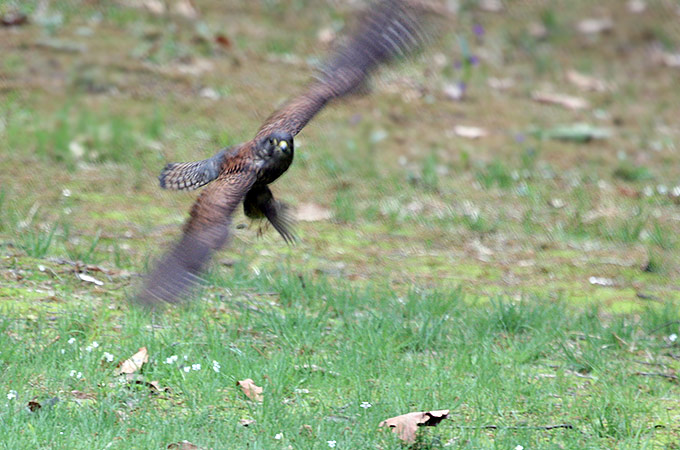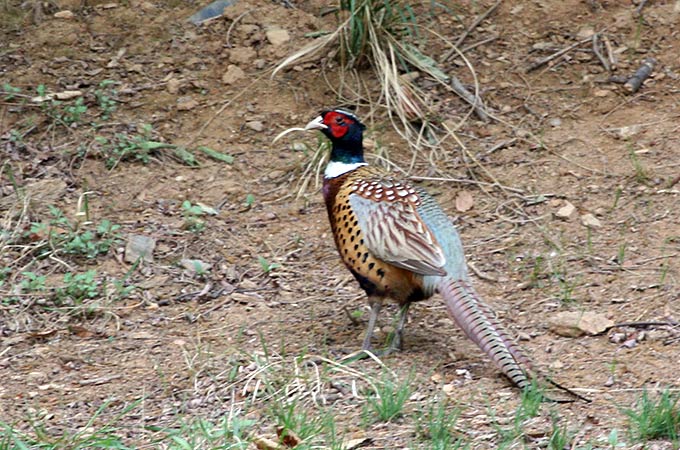 | E-mail to Birds Korea |
 | KWBS |
in the Region
 | The Oriental Bird Club |
 | BirdLife International (Asia) |
May
Like April, a great birding month. Temperatures begin to climb with day maxima often reaching 25°C by the end of the month, though feeling cooler on offshore islands due to low sea temperatures and wind. Fog can temporarily limit birding, while also causing spectacular falls of migrants.
Migration continues, and guided tours to estuaries or offshore islands can expect many spectacular days. Especially in the first week, diversity can be exceptional. Lesser Sandplovers, Red-necked Stints, Broad-billed and Spoon-billed Sandpipers peak at Saemangeum and other key areas, while Chestnut and Little Buntings begin to outnumber Yellow-throated and the very common Black-faced Bunting. Mugimakis, Dark-sided and Grey-streaked Flycatchers also start to arrive, peaking in the second and third weeks of the month. Brown and Tiger Shrikes, Siberian Rubythroats and Broad-billed Rollers add colour and quality to the birding mix. By late May locustella warblers (Gray's, Pallas's, Middendorf's, Styann's Grasshopper and Lanceolated) arrive on western islands. In forests Ruddy Kingfisher and Fairy Pitta are in territory and vocal, though still elusive and easily disturbed. Korean breeding Chinese Egrets and Black-faced Spoonbills remain widespread at the best sites, and Saunders's Gull also sometimes nest.
May is a prime month for finding national rarities. Korean firsts in May have included: in 2000, Ortolan Bunting and Northern Wheatear; in 2001, Himalayan Swiftlet and Asian Koel on Gageo Island, and Black Tern at Seosan; in 2002, Long-tailed Skua; in 2003, Isabelline Wheatear and Chinese Song Thrush; in 2004, an Orange-headed Thrush on Hong Island; and in 2005 three Tickell's Leaf Warblers on Socheong.
(The following records are a compilation of our own sightings and records sent in by other observers. As well as being posted on the Birds Korea website(s), selected records are also forwarded to other Korean-language birding websites; records of threatened species are arranged and forwarded to Birdlife International and national authorities when appropriate; flag images and records are passed to bodies responsible for their coordination throughout the flyway; and all records sent to us are used to compile annual reports and to support the evolving understanding of the status of many of Korea’s birds.)
SSMP: Simpo and Shellfish Harbour, May 23-24
A short addition or report-within-report from the SSMP.
One full day and a morning with the count, with the intent to photograph shorebirds: the Simpo count was much undermined by the closure of the sea-gates which prevented the tide from coming in. I spent the day with Richard Chandler; we encountered small numbers of Great Knots, a single Red Knot, and even smaller numbers of Red-necked Stints, Mongolian Plovers, and Bar-tailed Godwits. Richard rescued 6 Terek Sandpipers caught in a funnel-type fish net, and I spent some time admiring a flock of minnow-catching Little Terns.
The morning at Shellfish was enlivened by a good (for the late date) count of Grey-tailed Tattlers, Ruddy Turnstones, and Terek Sandpipers; passerines of note were a Black-capped Kingfisher and several Azure-winged Magpies.

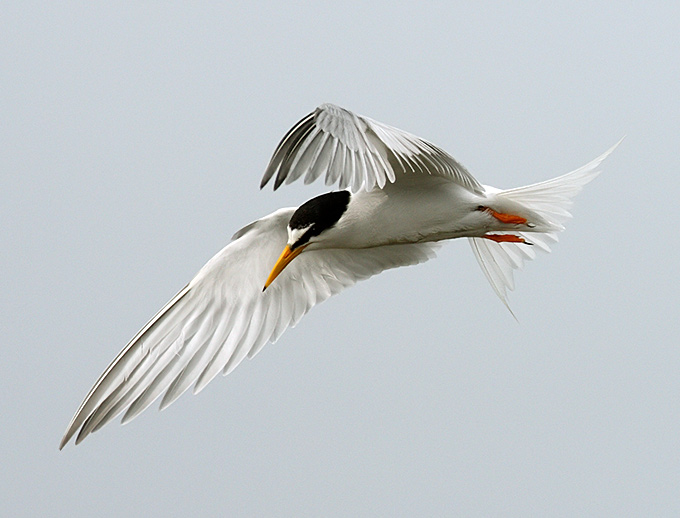

Geum Estuary, May 24
With a pre-dawn high tide of c. 6.2 m outside of the Saemangeum reclamation area (the last really decent high tide of this spring tide series) counting effort was again focused on the Geum Estuary. While most shorebirds have now departed (with several flocks also seen departing this day), a count of 1130 Broad-billed Sandpiper on Yubu Island seems exceptional, representing more than 1% of the perhaps over-generous Flyway estimate, and the largest concentration in Korea so far known to Birds Korea. Mixed in among this highly vocal flock (emitting an extremely beautiful rising and falling crescendo of buzzing trills), were smaller numbers of Dunlin and Red-necked Stint and at least 4 Spoon-billed Sandpiper (two in full breeding plumage, one in partial breeding plumage, and one in a perhaps second-calendar year [?] type muted plumage). In addition there were seven Nordmann's Greenshank, and a Gull-billed Tern (latter found and seen by Andreas Kim only: either a new bird or the same as the one from the 23rd), and closer to the village, both singing Lanceolated Warbler and a burst of song from a Styann's Grasshopper Warbler. During the evening high-tide, the same or another Gull-billed Tern showed well at the Geum barrage (with images confirming that this at least was the same individual as photographed on the 23rd within Saemangeum), and a further highlight came in the reappearance of a breeding-plumaged Asian Dowitcher seen shortly before dark. A total of three different Asian Dowitcher have been found during the SSMP 2008.

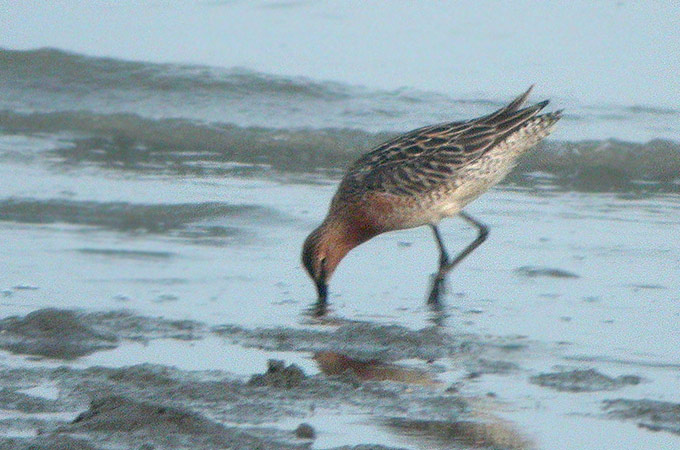
Seungbong Island, May 24
A brief five-hour circuit only of this inshore island, and in hot midday sunshine revealed apparently few migrants (with a modest day total of 44 species). Best was perhaps a Chinese Egret fishing by crouching over rock pools along the shore. Also of note, a White-throated Rock Thrush, Chinese Pond Heron, 4 Asian House Martin, singing Light-vented Bulbul (a first for this island), 2 Brown Shrike, 4 Eastern Oystercatcher and 5 Saunders's Gull off Incheon. Very little on the sea crossing, although 14 Common Tern and a spectacular cloud of Black-tailed Gulls being fed by day-trippers on the boat-deck. New development of a park and concreting of the stream, as well as apparent evidence of recent bird- shooting, seemed to have left the place rather quiet, with e.g. only 1 each of Arctic, Oriental Reed & Yellow-browed Warblers, Common Kingfisher, Dollarbird, Black-naped Oriole, Hobby, and a Common Moorhen.
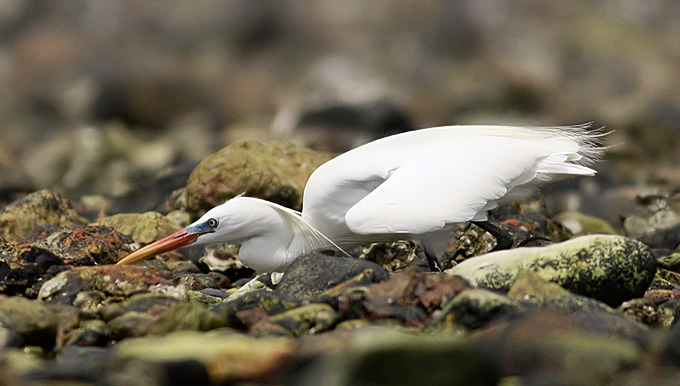
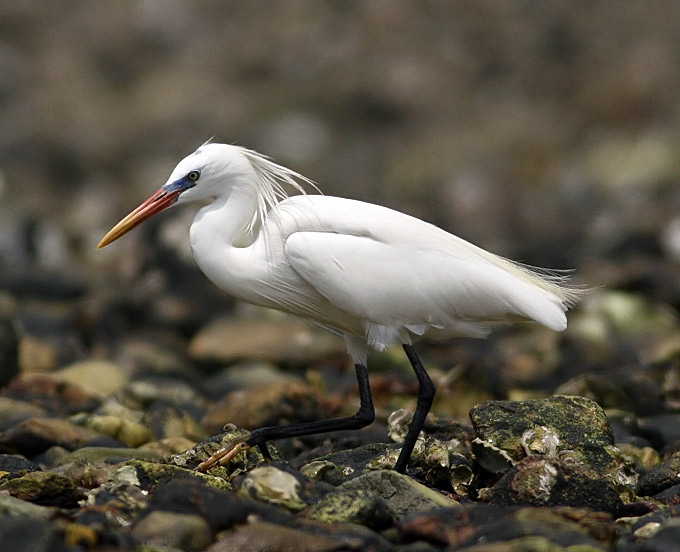

Gomso Bay and Saemangeum, May 23
Count effort was focused at Gomso Bay for the pre-dawn high tide, and then within the Saemangeum system, with teams both on land and covering areas by boat. While count data are still being processed, a total of c. 1055 shorebirds were logged at Gomso Bay, with Whimbrel (314), Terek Sandpiper (248) and Grey Plover (213) most numerous. Within Saemangeum, most apparent is the sudden drop in water level (of about 1.5m from high tide peak of May 22nd?), exposing vast areas of new wet mud, and combined with now-closed sluice gates, causing yet another mass die-off of benthos and small fish. Rather few shorebirds found, with non-shorebird species of most note an Osprey and a Gull-billed Tern (fewer than ten national records), found by Nial Moores and Richard Loyn on an island offshore from Gyewha Do.

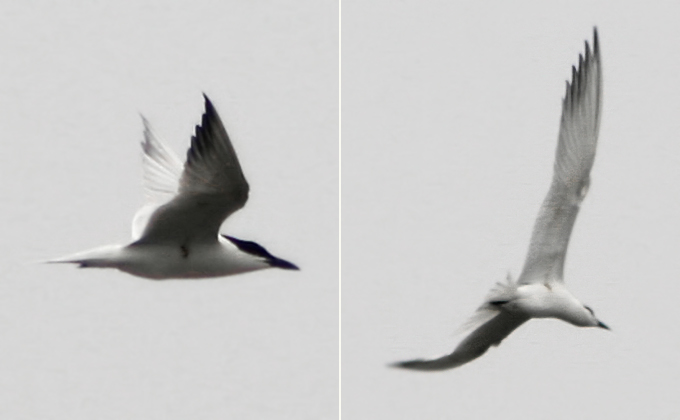
Simpo and Inner Dongjin (Saemangeum Reclamation Area), May 22
Day three of the SSMP Fourth Count Cycle concentrated on Simpo and the inner Dongjin, within the 40,100 ha Saemangeum reclamation (i.e. wetland destruction) project. With extremely poor water quality despite the increased tidal movement (with tidal range again more than 1 m) and large departures of shorebirds in recent days, only small numbers of shorebirds remained in the area. Birds present, however, included a Yellow-flagged Red-necked Stint, a confiding Oriental Pratincole, and best of all, two breeding-plumaged Spoon-billed Sandpiper, both showing excellently. Much better images are to follow..


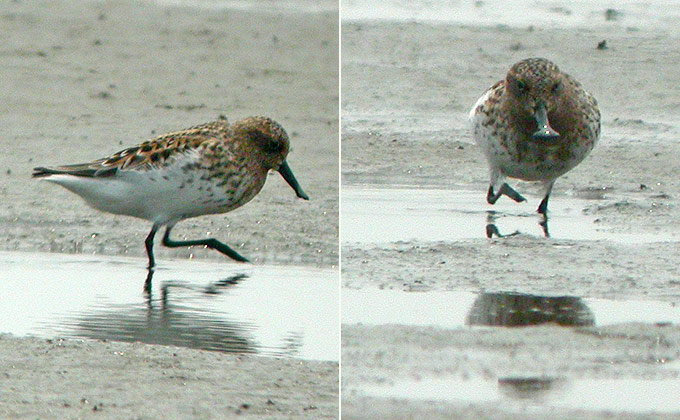
Mangyeung (and the Geum), May 21
With tides still of c 1.3 m within the Saemangeum reclamation, the second day of the Fourth Count Cycle, again concentrating within the Mangyeung Estuary, at Okgu and Hwapo. Rapidly decreasing numbers, as birds seen to depart. In the Hwapo/Seokso area, three Black-faced Spoonbill and two Chinese Egret, Dunlin, Red-necked Stint and Terek Sandpiper most numerous (numbers still being compiled), with a high density on now permanently dry former tidal-flat of nesting Kentish Plover and apparently Eastern Oystercatcher (the latter performing highly elaborate "broken wing displays", including swimming and flapping vigorously in the water as well as crouching on the ground, wings rolling).
No sign of the Spoon-billed Sandpiper at the Airport North (found on May 20).
At the Geum (at "Shellfish"), three Nordmann's Greenshank seen well, along with many more flagged birds recorded by the Global Flyways Network team. More details will be posted later.
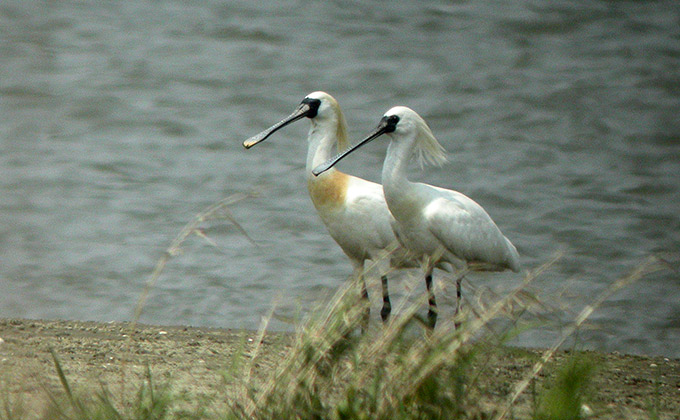

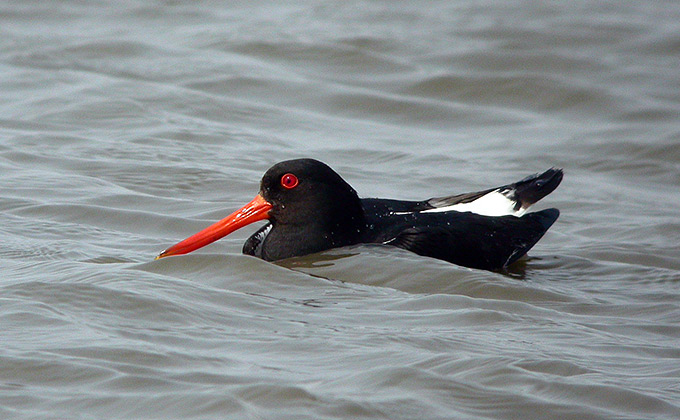
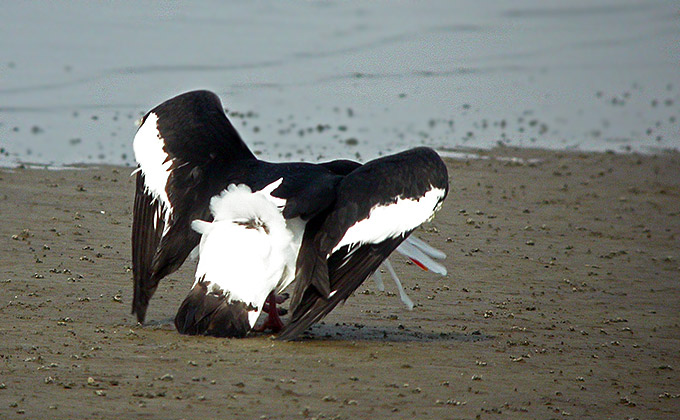
Eocheong Island, May 17-19
Taking a short break from leg-flag searches along the Korean coast, an excellent time on Eocheong with 95 species in total, including many birds seen very well, especially after a night of heavy rain on 18th. Highlights included: Yellow Bittern, two on May 19; Shrenk's Bittern, three on May 19; Pechora Pipit, three on May 19 Siberian Blue Robin (>60 daily); White-throated Rockthrush (4 on 17th, 14 on both 18th and 19th); Thick-billed Warbler (2 on 17th,2, on 18th and 5 on 19th); Black Drongo, one on 19th.
In addition, one Black Paradise Flycatcher was photographed on Eocheong by Richard Chandler on May 17th.
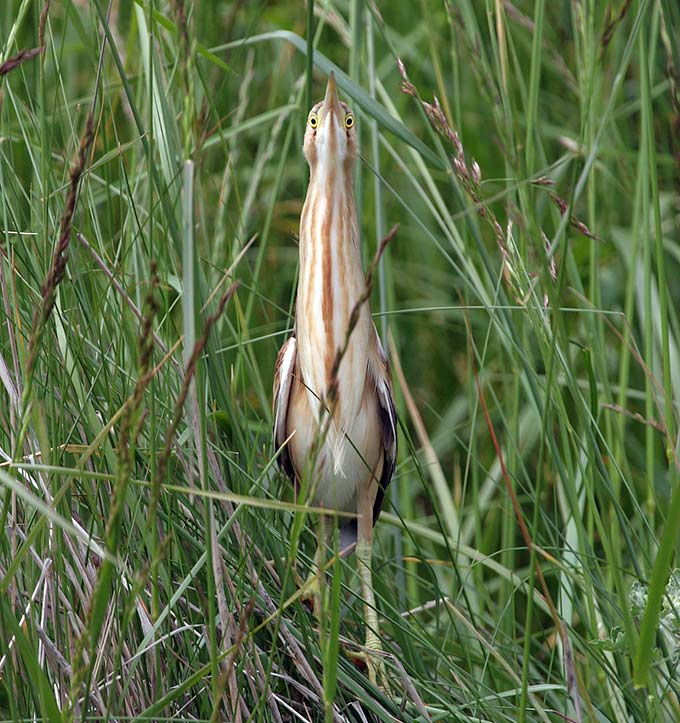

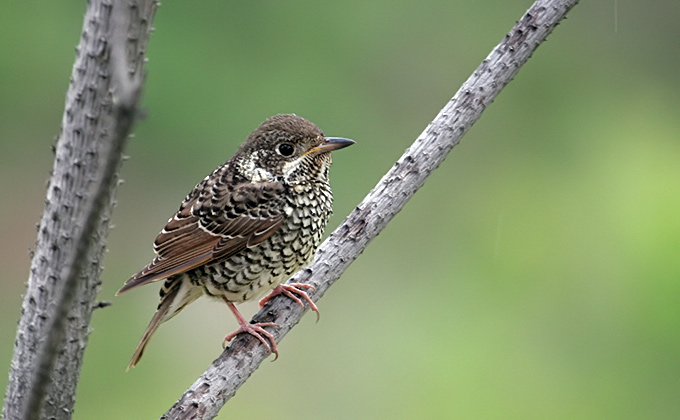

Socheong Island, May 19
Foggy and overcast overnight, with strengthening westerly winds becoming Beaufort Force 6 by midday. Between 6 AM and midday, 76 species logged in the west of the island, including the personal first Gray’s Grasshopper and Thick-billed Warbler (2) of the spring and another extremely late Red-flanked Bluetail (this one a male). Other species of note included a new White-breasted Waterhen (near the lighthouse), a Northern Hawk-Cuckoo seen briefly in second village, probably 40 or 50 Chestnut-flanked White-eye, three Grey-faced Buzzard and a Crested Honey Buzzard (all suggesting the start of some stronger diurnal movement) and a total of 21 White-throated Rock Thrush in areas not covered on the 18th. Further highlights included an extremely confiding Siberian Thrush (feeding on snails, worms and woodlice picked off the road near the lighthouse), and a briefly seen “sandy-backed” shrike, with a warmer crown and strongly toned tail, and a small but obvious white wing-patch: Isabelline or Brown Shrike? With waves reaching 5 m at sea, no seawatching was attempted from the ferry back to Incheon.
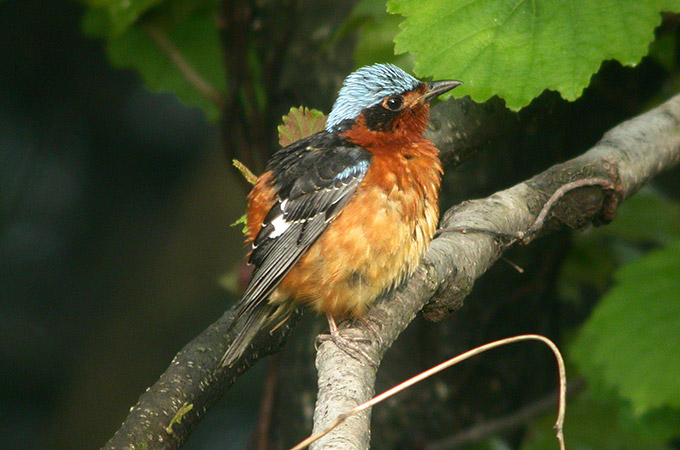

Weiyeon Island, May 18
Highlight was almost 100 White-throated Rock Thrush - (easily) a new national high count of this stunning species.
Socheong Island, May 18
Rain from 5 AM until 2 PM, then becoming showery with occasional brighter interludes, before clouding over again in the evening. While only a small, central part of the island was covered, still 92 species were logged during the day, with most obvious species including a Black-winged Stilt in the main village, Asian Brown (40) and Yellow-rumped Flycatchers (25), Siberian Blue Robin (25), and White-throated Rockthrush, with a possible national high count (?) of 16 of the latter seen. Other highlights included extremely confiding Rufous-tailed Robins, and a Siberian Rubythroat at North Point feeding in the open, at times down to 4 or 5 m range, while other species of note included another (presumed) Brown Shrike (with warm-colored upperparts and a very prominent white wing-patch), a Red-billed Starling, and the extremely wary White-breasted Waterhen still. Outstanding highlight came late in the evening, with a Japanese (or perhaps Malayan?) Night Heron, found by Robin Newlin several days before, relocated feeding on the road at dusk. Views in the field (confirmed by a series of very poor images) revealed that this immature bird has a blackish crown (with dark extending down the centre of the nape at certain angles), and fairly prominent white tips to the two outermost primaries (P 9 and P10) and much less prominent pale tips on P 7 and P 8 (both good features it appears for Malayan Night Heron). A recent review of specimens and the literature, however, reveals that non-adults of Japanese and Malayan Night Herons are far more difficult to identify than perhaps generally believed (D. Rogers, pers. com, 2008).
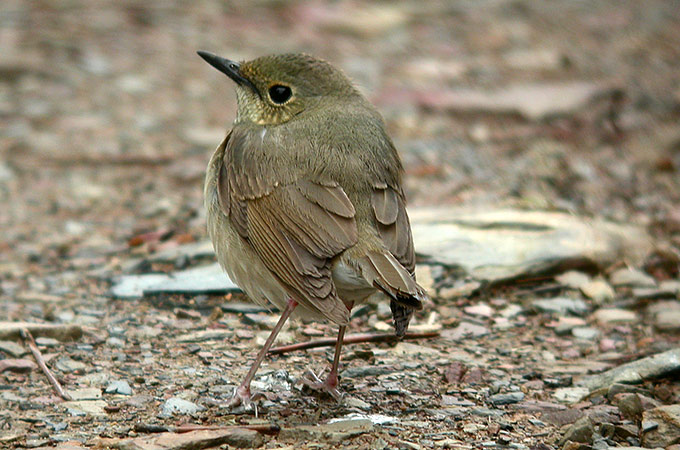

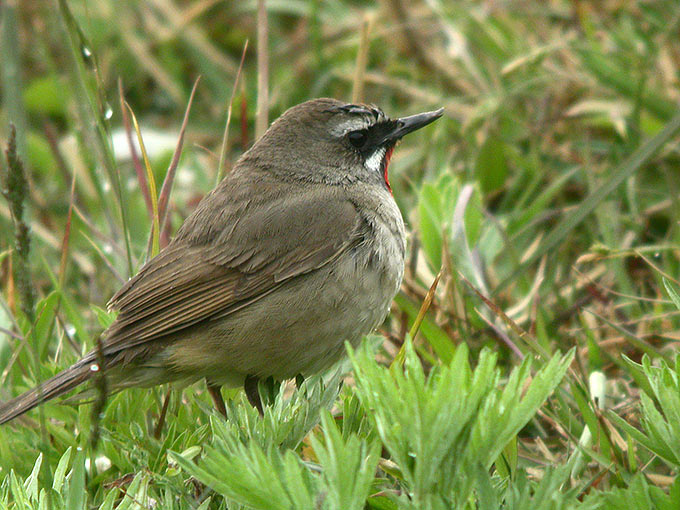


Socheong Island, May 17
An excellent day’s birding in beautiful weather, with warm sunshine and light westerlies breaking up the early morning fog. In total, 100 species logged during the day, with rarest a Siberian Chiffchaff seen for less than 10 seconds (NM only), and a broad range of spring migrants, including some species seldom recorded on Socheong and other more typical species proving both numerous and confiding. Scarce for Socheong species included an Eastern Oystercatcher, a Grey-tailed Tattler and a White-breasted Waterhen, while colourful highlights included a Black-capped and a Common Kingfisher sat next to each other (apparently staring each other down!), at least 18 Yellow-breasted and 20 Chestnut Buntings, eight species of flycatcher (including Yellow-rumped [30], and Mugimaki [20], Blue-and-White [one male, one female], Narcissus [one male, one typical female, and one apparently female type showing yellow tones to the throat and some yellow speckling on the rump], and Red-throated [4]), at least 75 Siberian Blue Robin, 6 Thick-billed and 20 Brown Shrikes, extremely late Red-flanked Bluetail and Brambling (both singles), 5-6 White-throated Rockthrush and a female Daurian Starling. Further (subtler!) species of note included 3 Pechora Pipit, 2 Lanceolated , 4 Pallas’s Grasshopper and 10 Two-barred Greenish Warblers. Two Spotted Seal provided the mammal highlight of the day.

Yongjeong Island, May 17
Shock new construction of a road has gouged the formerly favoured stream and woodland edge off the map at Yongyudo, and the southern lock reservoir is now a birdless concrete shell: however, still a surprisingly good day count for the area as a whole. Most surprising, two Chinese Penduline Tit (unusual for May?), two Grey-streaked Flycatcher and a lucionensis Brown Shrike. Also two dashing Chinese Egret, a very yellow personata Black-faced Bunting and a Common Redshank. The nicely extensive saltpans held 35+ Grey-tailed Tattler (highest concentration seen yet) as well as 15 Dunlin, 20 Red-necked Stint, a Green Sandpiper, and spectacular close views of Little Terns plummeting into the water. On the mudflat 160 Bar-tailed Godwit, 8 Great Knot, 12 Mongolian Plover, 90 Terek Sandpiper and c.270 Whimbrel, with Eurasian Curlews also present. In the trees, pleasing to see all the regular summer visitors such as Black-naped Oriole, Common Kingfishers, Dollarbirds and Common Cuckoo all back with us again. Two songsters, (hovering high above) were perhaps Northern Skylarks.
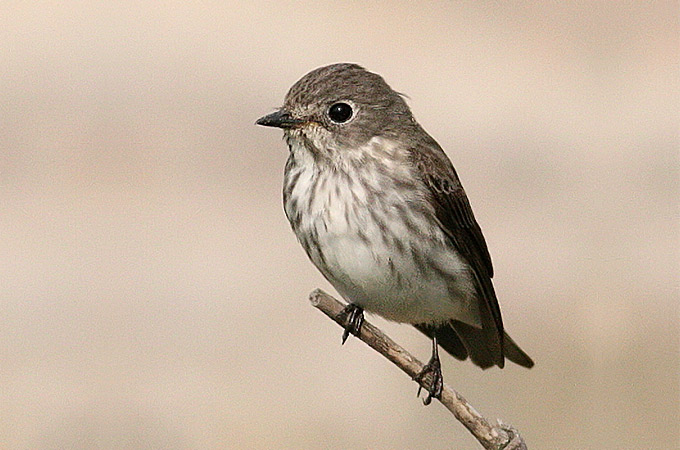
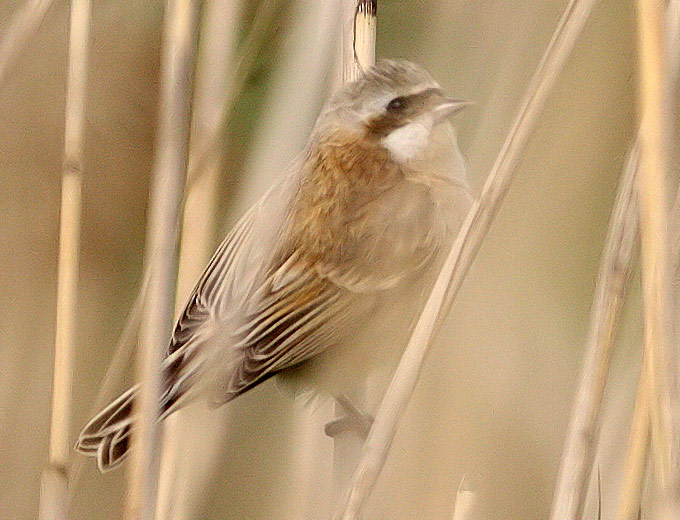
Incheon Ferry and Socheong Island, May 16
Mostly sunny, with warm sunshine, light southwesterly winds, and occasional fog banks. A total of 87 species logged during the day, with both breeding-plumaged Arctic (3) and Pacific Loons (8) and a very poor total of 7 Streaked Shearwater seen from the ferry, along with further highlights of several Finless Porpoise, a Common Moorhen out over the open sea, and the island’s first record of Pacific Reef Egret, this seen on the rocks off the Socheong lighthouse. On the island itself, most numerous migrants included Yellow-browed Warbler (100), Siberian Blue Robin (40), Black-faced Bunting (40), Mugimaki (25) and Asian Brown Flycatchers (25), Brown Shrike (20, including one warm-crowned, reddish-backed individual with a prominent white wing patch) and Pale-legged Leaf Warbler (20), while other species of note included 4 or 5 Light-vented Bulbul (all apparently in territory), decent views of a Forest Wagtail, and 6-8 Red Crossbill.
Baekryung and Socheong Islands, May 9-15
From the ferry to Baekryungdo: very quiet up until the last hour before the island, when about 30 Streaked Shearwaters, a few Ancient Murrelet and Loons (some appeared although distant to be Pacific) and 2 Jaegers at different spots; one appeared to be a Parasitic Jaeger.
On Baekryung from about 6:30 pm till nightfall: 2 Brown Shrike and several Mugimaki Flycatchers; smaller numbers of Brown, Blue and White, and Streaked Flycatchers, and one very intriguing "green" Ficedula: showing very green head and back, dark flight feathers, large white wing patch, and bright yellow throat and breast (seeming to fade toward belly), and a deep yellow loral stripe, distinct from beak to eye and absent behind the eye. Other birds in the area were Chestnut and Little Buntings, Korean Bush, Pale-legged Leaf, Yellow-browed and Arctic Warblers, Siberian Blue Robin, Indian Cuckoo, Olive-backed Pipit, and Chinese Sparrowhawk.
The morning of the 10th seemed to hold fewer birds. Highlights were splendid looks at an Oriental Pratincole, a Yellow-breasted Bunting, a Yellow-browed Bunting, a Pechora Pipit, a lingering Common Buzzard, a Sharp-tailed Sandpiper, 4 Eastern Oystercatchers, a Pacific Golden Plover, several Mongolian and Kentish Plovers,, a Skylark, 1 each of Buff-bellied, Richard's, and Blyth's Pipits, and a flock of 30 Yellow Wagtails with one Taivana noted. Finally, two Chinese Bulbul had the proprietorial feel of being on territory; this would suggest a further expansion of their range.
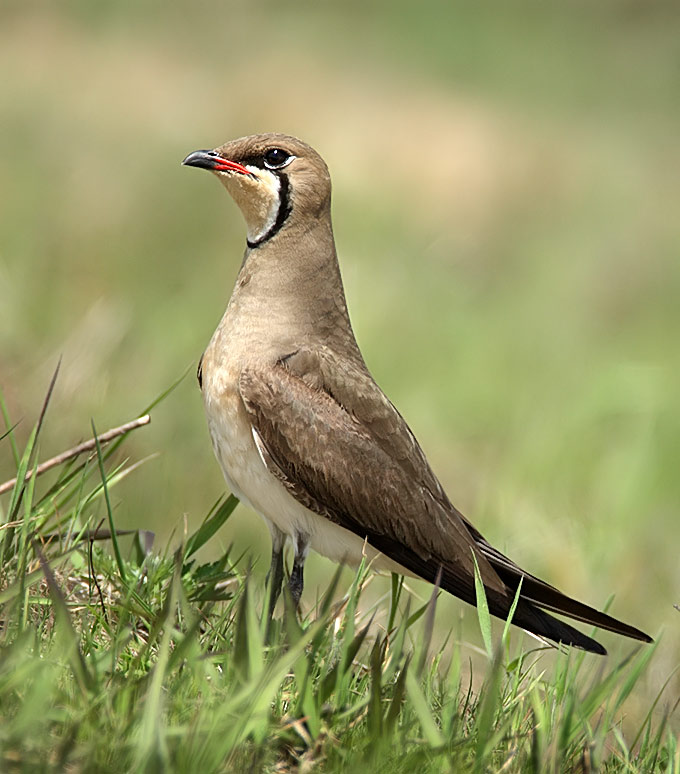
The 11th took me the short distance to Socheong-do. Small numbers of birds in evidence, and generally single digits of the following highlights: Ashy Minivet, Chestnut-eared Bunting, Streaked, Brown, Blue and White, Yellow-rumped, Mugimaki and Red-throated Flycatchers, Eye-browed Thrushes (in seeming large numbers but very elusive), Grey-faced Buzzard, Radde's and Dusky Warblers, Scops Owl, Asian Stubtail, Asian House Martin along with a flock of swallows. A few Rufous-tailed Robins and Siberian Rubythroats.

The 12th began with rain in the pre-dawn hours; it rained with varying intensity all day. New birds were a Chinese Pond Heron seen flying in, single Pallas' Grasshopper and Black-browed Reed Warbler, Common and Oriental Cuckoos suddenly calling, a Pallas' Reed Bunting, a Northern Hawk Cuckoo Calling, a flock of Chestnut-flanked Whiteyes, and a single Black Drongo. 1 Scaly Thrush, 13 or so Chinese Grosbeak, a Common Sandpiper, several Chestnut-eared and Meadow Buntings, Brown Shrikes and a Northern Boobok. Raptors included omnipresent Chinese Sparrowhawks, a single Japanese Sparrowhawk, and a couple of Peregrine Falcons. Small flocks of White-throated Needletails appeared now and then.. Highlights of the day came within an hour or so of each other in the late afternoon: a brief flight view of a Japanese Night Heron and then later, in a large flock of Swallows, a Eurasian Crag Martin. As the sun went down among the rainclouds, a Large-hawk Cuckoo began calling very loudly near the village - almost exactly in the same area as last year's first record by N.M. et al.! This (returning?) bird gave a full concert, including the notorious "brain fever" finish. As the sun went completely down, the feel was of increased movement of arrivals…
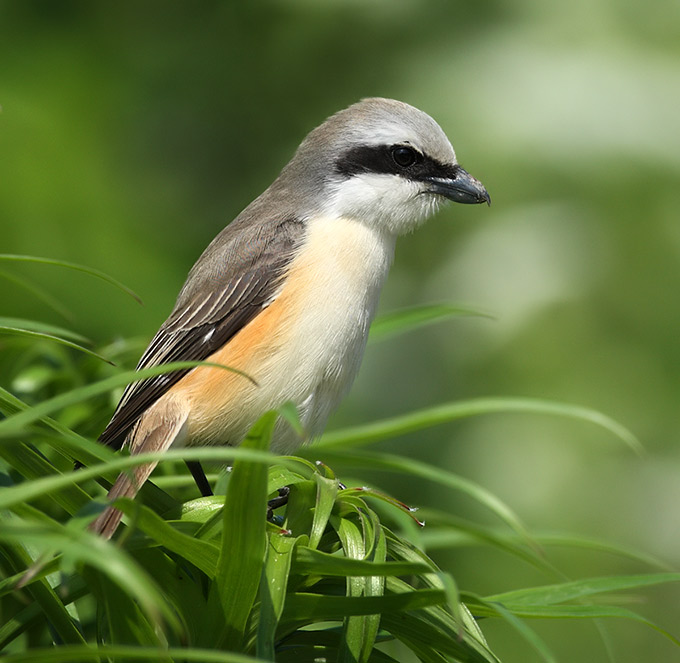
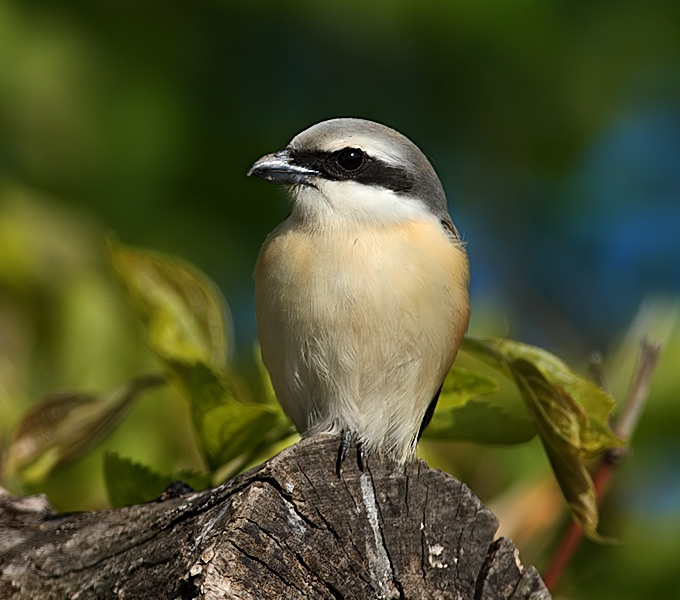
After a few hours of clear weather, continued rain on the 13th. If anything, the second weather system seemed to have pushed birds out rather than in: a marked reduction in the previous day's already small overall numbers. The Large Hawk Cuckoo made no more signals. Siberian Rubythroats were suddenly invisible. Great compensation, however, from 2 Japanese Grosbeak joining the growing Chinese Grosbeak (approx. 24 birds) flock, and especially from excellent views of the Japanese Night Heron: in flight again in the morning; and finally, in the evening drizzle, as it walked along the side of the road, eating worms and slugs caught against the concrete lip of the road. Before that, I was even treated to the sound of its territorial song while it was still in the forest: a throat-clearing cough followed by three deep hoots.
The 14th was clear but cold; the winds came strong and steady from the Northeast, boding ill for migrants. New birds were a Pied Harrier, a Black-capped Kingfisher, a Thick-billed Warbler, a Daurian Starling, a Grey Wagtail, a singing Lanceolated Grasshopper Warbler, a Grey Thrush, an Oriental Reed Warbler and a small group of Siskins. 4 Richard's Pipits at North Point were joined by a Yellow-breasted Bunting and an unidentified snipe. At Northeast Point, large numbers of Black-naped Orioles flew out over the ocean, encountered the winds, and flew back.

Continued cold on the 15th, and few birds noted in the few hours before the boat. Highlights were a Two-barred Greenish Warbler and a Yellow-browed Bunting. As I was leaving, the winds seemed to shift, coming from the Southwest, boding well for migrants. The return ferry was quiet, with a few Ancient Murrelets and Streaked Shearwaters, a few loons, this time looking rather like Arctics, and a Northern Boobok.
Gangwon Province East Coast Lagoons, May 12
Over the Buddha's birthday long weekend I visited some of the lagoons on the East Coast of Gangwon Province with Kim Seong-Mi. The number of birds is less than it has been during winter and early in spring, but there were still a few winter visitors and passage migrants around. There were also some summer visitors present around the lagoons and associated habitats.
Cheongcho Lagoon in Sokcho: I visited Cheongcho laggon on the May 10 and 11. A pair of Mallards were still there. Some Grey Herons, a Great Egret, a Little Egret, some Great Cormorants, Spot-billed Ducks, a Common Sandpiper and a Little Grebe in breeding plumage were also present. Fifteen Grey-tailed Tattlers and a Terek Sandpiper were resting on the artificial roost, as they were around the same time last year. An Oriental Reed Warbler heard in the long grass. There were only 2 Black-tailed Gulls present.
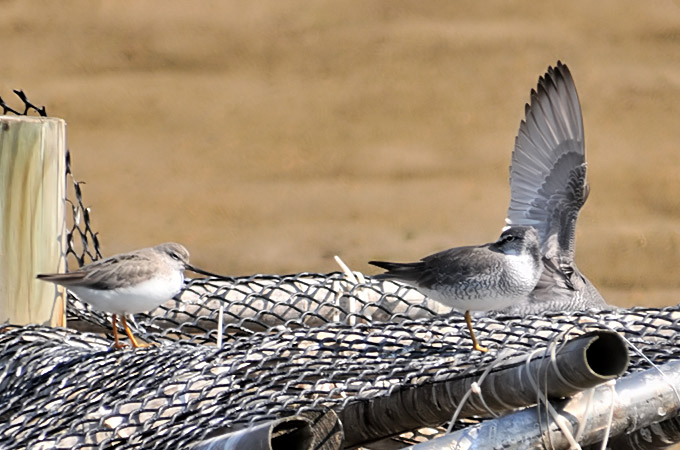

Yeongnang Lagoon in Sokcho: We drove around Cheongcho Lagoon on May 11. We found 2 female Greater Scaups and a female Common Merganser there. Around the lagoon we saw and heard Oriental Reed Warblers, Eastern Crowned Warblers and a Black-naped Oriole.
Hwajinpo Lagoon: On Hwajinpo Lagoon on May 11 we saw 36 Tufted Ducks, 8 Spot-billed Ducks, 3 Mandarin Ducks and 2 Mallards. Birds of interest around the lagoon included some Grey Herons, an Eastern Great Egret, a Moorhen, Oriental Reed Warblers, Common Kingfishers and a Black-capped Kingfisher.

Songji Lagoon: There were some late winter visitors at Songji Lagoon on May 11 as well. These included 8 Mallards, 18+ Tufted Ducks and 2 Greater Scaups. Eastern Great Egrets including recently fledges juveniles were seen in rice fields near the lagoon. Other birds in the flooded rice fields included Wood Sandpipers, Common Snipe and Grey Herons.

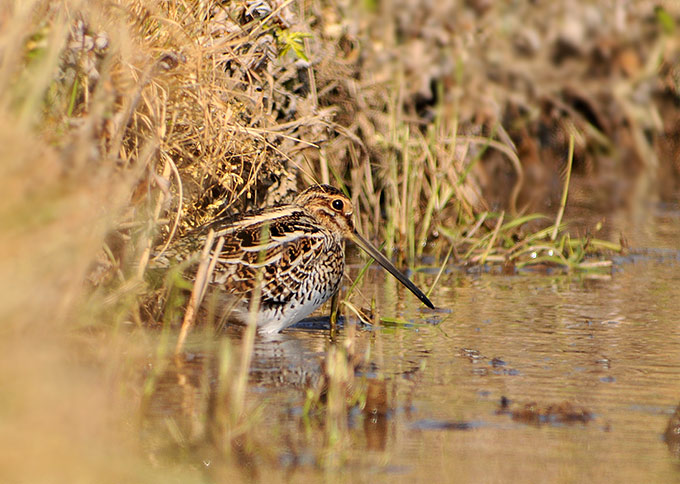
Namdae Cheon near Yangyang: We visited Namdae Cheon on May 12 and found some good birds. There was an Osprey over the river. A Chestnut-eared Bunting and Siberian Stonechats were in an area of regenerating Robinia pseudoacacia trees on the north side of the river. Closer to the river in the wetter areas were 2 Zitting Cisticolas, Oriental Reed Warblers, Common Pheasants, 2 Moorhens, a Coot, Little Ringed Plovers, White Wagtails Motacilla alba leucopsis, a Grey Wagtail and a Common Sandpiper. Ducks included Spot-billed Ducks, Mallards, 2 Pintails, 2 Falcated Teals, 8 Eurasian Wigeons, 5 Common Teals and a Common Merganser. Driving along the south side of the river we heard and then saw a Hoopoe. Other bords included Grey Herons, Great Egrets, Little Egrets and a Great Cormorant.
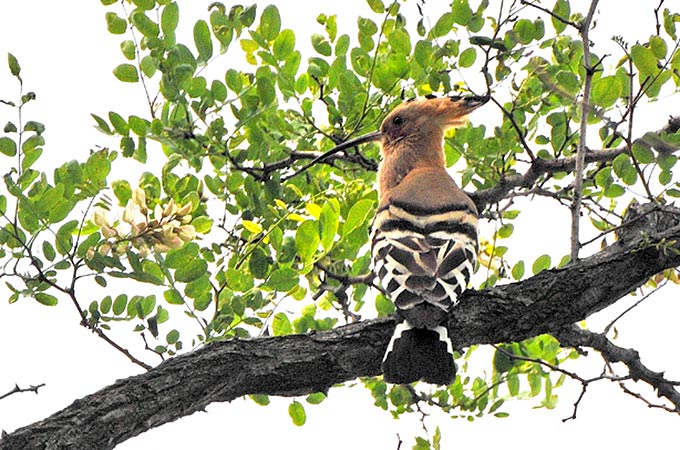
Gyeongpo Lagoon: Our final destination on May 12 was Gyeongpo Lagoon and surrounds. There were very few birds on the lagoon itself compared to winter. We did find 6 Pochards, 10 Spot-billed Ducks, 2 Mallards, 4 Little Grebes, a Tufted Duck, a Greater Scaup and a Coot on the lagoon. On the island in the middle were some Grey Herons and an Eastern Great Egret. Around the ponds near the there were Pale Thrushes, Brown-eared Bulbuls, a Common Kingfisher, Grey-capped Greenfinches, Long-tailed Tits, Great Tits, Oriental Reed Warblers, a Common Cuckoo and a Great Spotted Woodpecker.
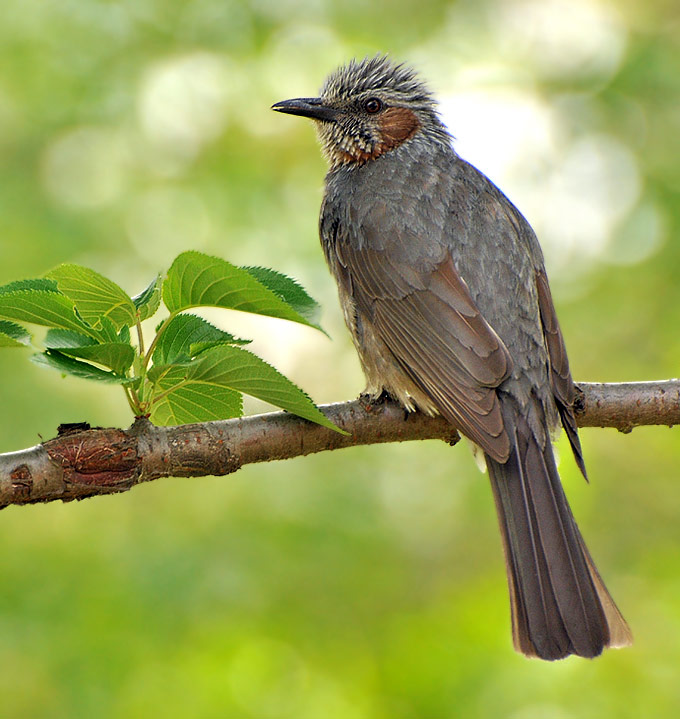
Songdo, May 12
The Mongolian Gull colony appears to have swelled to eight nests now, with one containing 2 waddling chicks. The rapid development here and temporary landscapes appearing, has also put Kentish plovers into breeding-type behavior on the newly created "arid plot", and even Eastern Oystercatchers were seen performing some sort of territorial stooping display. Best, six Black-faced Spoonbill and 87 Saunders's Gull: the First-summer individuals are showing dark tail-bands and incomplete hoods.Otherwise notable 4 Wigeon (scarce here) and 4 Black-tailed Godwit. On the last mudflat (where tide out, so approximate counts only) , c.300 Mongolian Plover, At least 600 each of Dunlin and Grey Plover, 150 Bar-tailed Godwit, 500 Red-necked Stint, 350 Terek Sandpiper, also plentiful Kentish Plover, and now only c.10 Whimbrel. Little Terns proved just too swift for the camera..
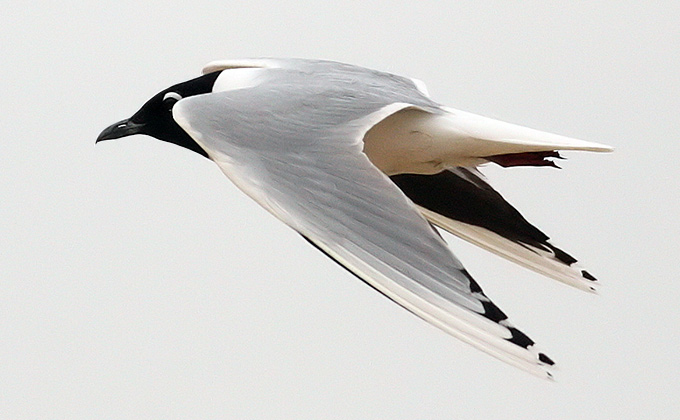


Geum, Geum Barrage, Saemangeum, May 11
The 3rd SSMP count cycle now fully underway (news to follow), a look back on what the team have been up to since the 2nd count cycle (April 30th - 6th May):
April 30: Counts were made at various sites at the Geum and Saemangeum with a total of 39, 583 birds including 2,745 Bar-tailed Godwit, 20,264 Dunlin, 5,866 Great Knot, 422 Terek Sandpiper and 660 Black-tailed Godwit. There was also a viewing of a Dunlin from Taiwan (white over blue flag).
May 1: Highlight of this day were three Great Knots form Chongming Dao, China at the Geum Barrage with 1,100 Bar-tailed Godwit, 1,500 Dunlin and 50 Black-tailed Godwits among others.
May 2: The whole SSMP team headed to the Geum toaday with 850 Terek Sandpiper in one roost, 1,670 Bar-tailed Godwit, 750 Dunlin and 700 Great Knot. Interesting flags included a Dunlin from Taiwan, Great Knots from Chongming Dao and a Bar-Tailed Godwit from Queensland.
May 3: Species found at Okgu in the Saemangeum area today include 6,237 Dunlin, 1,173 Red-necked Stints, 252 Terek Sandpiper, 480 Grey Plovers, 662 Great Knot and 445 Bar-tailed Godwit. Flags included Grey Plovers from Taiwan and Chonming Dao.
May 5: After a day of rest (although birding was still of the day's activities!), a count at Wulpo in the Geum provided 16 Common Redshank, a mixed roost of c 800 Grey-tailed Tattler and Terek Sandpiper, 260 Whimbrel and 248 Dunlin. Another team headed out to nearby Shellfish, also in the Geum, with 1 Spoon-billed Sandpiper, 5 Nordmann's Greenshank, 2 Chinese Egret as the highlight along with 7,000 Bar-tailed Godwit, 2,000 Dunlin, 2,750 Great Knot and 1,650 Terek Sandpiper which have shown a sharp increase in numbers in the Geum and Saemangeum. To add to the great day, a Dunlin from Alaska, another one from Chongming Dao, 2 from Taiwan and also Bar-tailed Godwit from Hong-Kong, Australia and New Zealand.
May 6: Today the teams concentrated on the Saemangeum area with 20,414 birds in total counted including 2 Spoon-billed Sandpiper, 5 Saunder's Gull, 1 Curlew Sandpiper, 1 Greater Sand Plover, 106 Broad-billed Sandpiper, 6 Green Sandpiper, 3,198 Great Knot, 9,577 Dunlin and 1,064 Bar-tailed Godwit.

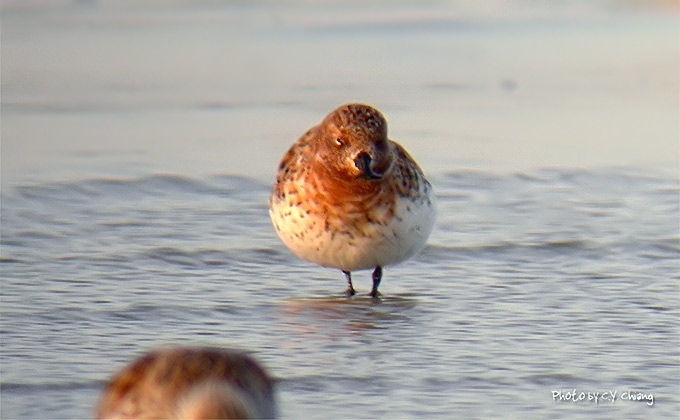
Jeongbalsan, Ilsan, May 10
The steady trickle of migrants and visitors to my ‘secret quiet forest edge’ on Jeongbalsan continues. Asian Brown Flycatchers are the most abundant species of late, with about a dozen seen, and many others heard. Two Grey-streaked, several female Mugimaki, a male Blue and White, and two male Yellow-rumped Flycatchers were also seen busily feeding. Yellow-browed Warblers were also present in strong and vocal numbers, and several Asian Stubtail were heard but not seen. Three Rufous-tailed Robins were seen, and several others were heard. A male Chestnut Bunting was seen near some Tristram's and Black-faced Buntings. Black-naped Orioles have returned to Jeongbalsan, mewling loudly from the treetops. Also seen was a Brown Shrike and a possible Eyebrowed Thrush.
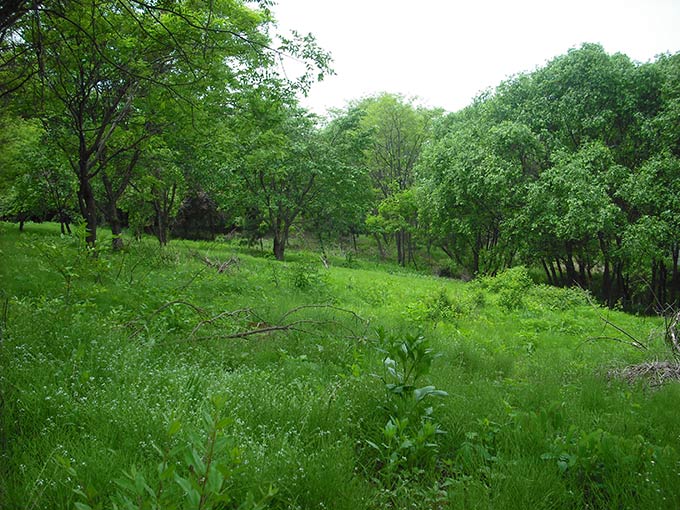
Photos © Mathew Poll

right: Yellow-rumped Flycatcher Ficedula zanthopygia Photos © Mathew Poll

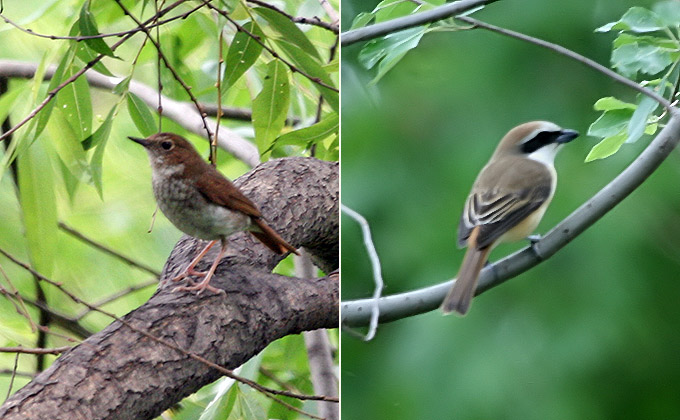
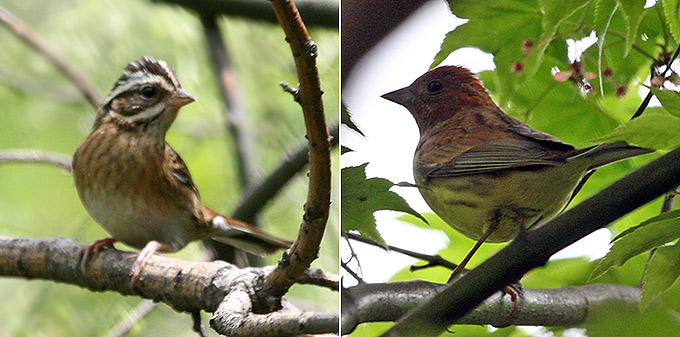
Namyang Bay/Hwaseong Reclamation Lake
A flock of twelve Pied Avocet, present since (at least) May 7, is the largest flock recorded in Korea known to Birds Korea. There are also 20 Black-faced Spoonbill in the same area.


Saemangeum/Geum Estuary, May 8
A very high tide (at 5 AM) led to an initial estimate of 60,000 shorebirds roosting at the airport tidal-flats within Saemangeum, with many of these then flying back across to the Geum Estuary as soon as the tide started to drop. In the dawn count at Yubu, probably more than 50,000 shorebirds, including at least 7 Spoon-billed Sandpiper, and probably 56 Nordmann's Greenshank.

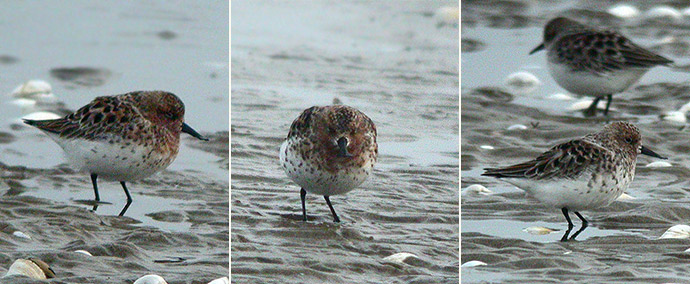

Preliminary Update, May 3-6
A wide range of internationally important sites for shorebirds covered by several teams of highly experienced counters (including members from Birds Korea, Miranda Naturalists Trust in NZ, Broome in Australia, and from the AWSG and Taiwan Wader Studies Group), covering adjacent sites simultaneously over this spring high tide series. Sites so far surveyed are: Yeongjong Island and Song Do (May 3rd); Ganghwa and Teibu Do (May 4th); Namyang Bay and Asan Bay and the Kia Tidal-flat (May 5th); rice-fields near Namyang Bay (May 5th), and west and east of Seosan Lake A (May 6th); and the remaining tidal-flats of Cheonsu Bay (May 6th). These sites have been covered before the National Survey counters rejoin the main SSMP for 7th and 8th, before then continuing on again along the west and then the south coast, from 9th to 14th/15th of May. While data compilation is still underway (and analysis at least two weeks away!), most striking already has been the extent of the loss and degradation of shorebird habitat, even over the past decade (since NM's last national shorebird survey). Much of the Song Do tidal-flat area (largely inaccessible in 1998 during that year's national shorebird survey) has now been reclaimed; and the eastern, innermost part of the remaining area is now being dyked for a new road project (with most of the rest slated for an extension of the Song Do New City); the main roost area at Shiwa is now being built on; tidal-flats at Teibu have become more disturbed; most of Namyang Bay (one of the nation's most important shorebird sites in both 1988 and 1998) has now been reclaimed, with the seawall there completed in 2006; the best shorebird areas in Asan Bay (which held a single flock of 18,000 Black-tailed Godwit and over 12,000 Great Knot in 1998) are now dyked, and although the seawalls there are still somewhat porous, the area will likely soon be built on; the rice-fields at Honwon Ri (between Namyang and Asan Bays) which supported thousands of Black-tailed Godwit in 1998 were godwitless this visit, with much of the surrounding area "under construction"; and the rice-fields at Seosan seemed very shorebird-poor, with apparently much lower densities of birds than in previous years. In addition, Saemangeum of course is clearly severely degraded, since seawall closure in April 2006.
Against this very negative background selected highlights have included at least five pairs of nesting Mongolian Gull at a mainland site in Incheon (the first mainland breeding record?); a total so far of 35 Nordmann's Greenshank (with highest counts being of 11 at Song Do South and 21 at Namyang South); almost 2,000 Black-tailed Godwit in rice-fields near Namyang Bay; two Oriental Pratincole and much less expected a juvenile Lesser Frigatebird (!) overflying Seosan Lake A (on May 6th); and a "twitched" adult Japanese Night Heron (found by members of the SSMP near Buan on May 4th), watched late on the 6th as it fed voraciously on worms and frogs.
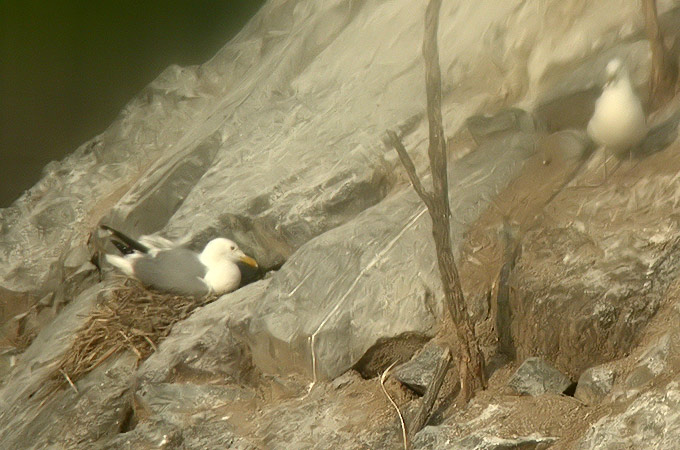
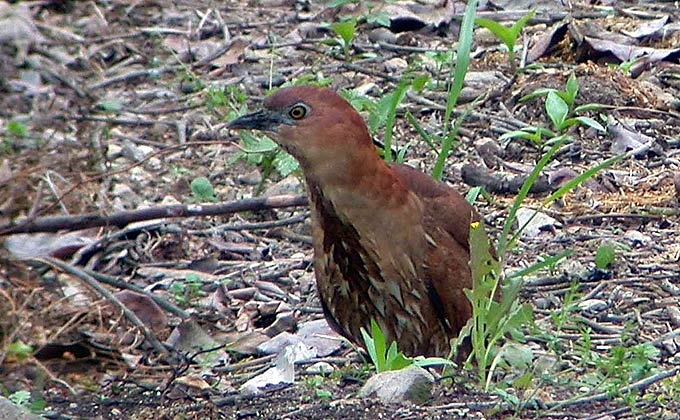
More details on shorebird numbers and other highlights will be posted soon, as time allows.
Nial Moores, Birds Korea, May 7 2008
Hwaeomsa, Jirisan, May 7
Seven -or perhaps up to 9- Hill Pigeon rested on the roof of the temple: showing their distinctive white tail patterns: there did not appear to be any nesting activity although some were quite territorial around their chosen gables. The odd individual was seen flying off over the surrounding mountain forest, where they presumably feed. The vocalisations seem fairly different from other pigeons- more gutteral and with different intonation.
Along the nearby stream, a Common Kingfisher and pair of Grey Wagtails, with a lone foraging Azure-winged Magpie nearby- strange to see as they are always in noisy flocks outside the breeding season at least.
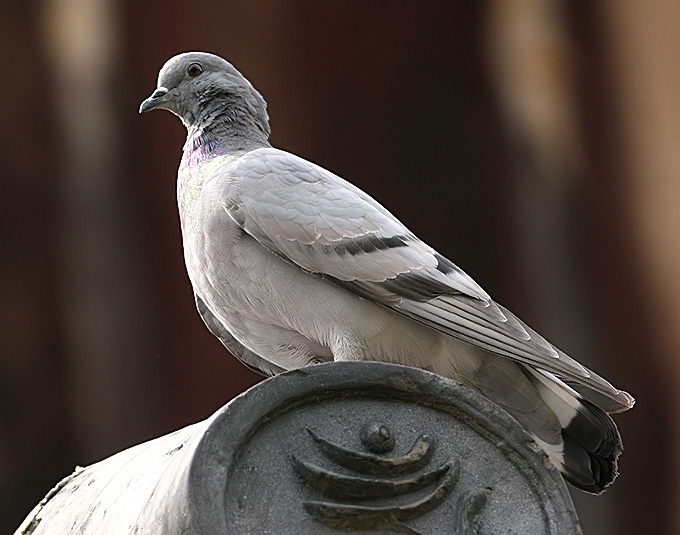
Gaggeo Island, May 4 - 6
May 6
The morning added 2 Oriental Dollarbird, a Dusky Warlber, a Grey-streaked Flycatcher, 1 Common Moorhen and now 3 Grey-faced Buzzard: at least 2 Japanese Yellow Buntings were seen again, before leaving the island with 64 species logged.

May 5
Bright and dry on an island dripping with birds, immediately apparent were up to 60 "macronyx" Yellow Wagtail with 3 ocularis White Wagtails; a Long-toed Stint, Common Greenshank, Wood & Common Sandpiper. Exploration was hard going, with the island being steep and pountainous, covered in dense scrub and bordered only by jutting rocks. Thirteen Cattle Egret made a pretty picture sitting on the backs of grazing cattle. Few raptors, with only an Osprey, 2 Peregrine, 3 Chinese but perhaps 20 Japanese Sparrowhawks actively hunting. Passerines hunkered down into scrub, nevertheless 2 and possibly 4 Japanese Yellow Buntings found, along with 1 Little, many Black-faced, 6 Chestnut, 2 Tristram's, and 2 (extraordinarily late) Rustic Bunting. Pale-legged Leaf Warblers were most abundant, followed by Yellow-browed, Arctic, Eastern Crowned & 3 Oriental Reed Warblers: plentiful Asian Brown and 4 Narcissus Flycatchers, numerous Japanese White-eye, 2 Ashy Minivet, plentiful Olive-backed & 2 Red-throated Pipit, a male Chestnut-cheeked Starling and Grey-backed Thrush, c. 10 Pacific Swift, 1 Oriental Cuckoo, and a Red-flanked Bluetail. Birds trickled in, with numbers of Great & Little Egrets, Striated, Grey, and Black- crowned Night Herons appearing by evening. Fishing from seaweed-covered rocks was a Common Kingfisher with a Black-capped Kingfisher nearby. Feeding broods were Varied Tits and Bull-headed Shrikes, the latter apparently glutting themselves on exhausted migrants.

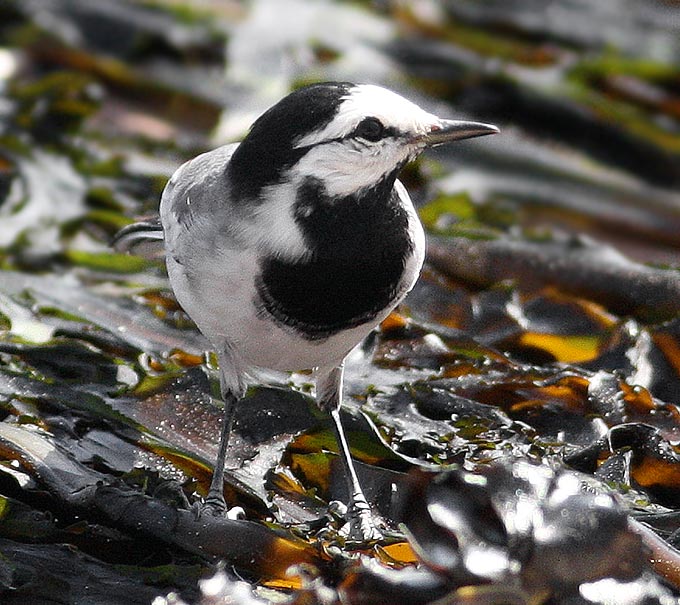

May 4
During the 5 hours + crossing, very little chance for seawatching, although 6 Streaked Shearwater at sea and an Eastern Oystercatcher at Bigeum-do. Korea's South-westernmost point, Gaggeo-do greeted me with a torrential downpour, after which a brief evening look revealed a Siberian Blue Robin frantically chasing insects on the concrete pier, at least 6 Asian House Martin (identified by shallow tail-notch), 2 Red-rumped Swallow, plentiful Japanese Bush Warblers singing in the rain, 2 Yellow-browed Bunting and a Grey-faced Buzzard..
DeokJeok Do, May 3-5
A weekend of mixed rain and sun on DeokJeokDo. The highlight was watching a male Chestnut-cheeked Starling that appeared to be catching insects from its perch on an antenna for 20 minutes, right outside the window of the minbak that I was staying in.
At least a dozen Yellow-browed Bunting were mingling with a similar number of Tristram’s and Black-faced Bunting. Several Korean Bush Warblers sang loudly from hidden perches the whole weekend. At one point one defended its perch from an Olive-backed Pipit. A Eurasian Hobby was harassing a large flock of Barn Swallow.
10 Cattle Egret followed a tractor as it plowed a rice field, while several Little Bunting fed at the edge of the same field. Also seen were a dozen Chinese Grosbeak, a Common Kingfisher, a Black-naped Oriole, abundant Grey Wagtail, a male Chinese Sparrowhawk, a Little Egret, and several Blue Rock Thrush engaging in courtship diplays. The only shorebirds seen were 4 Eastern Oystercachers.
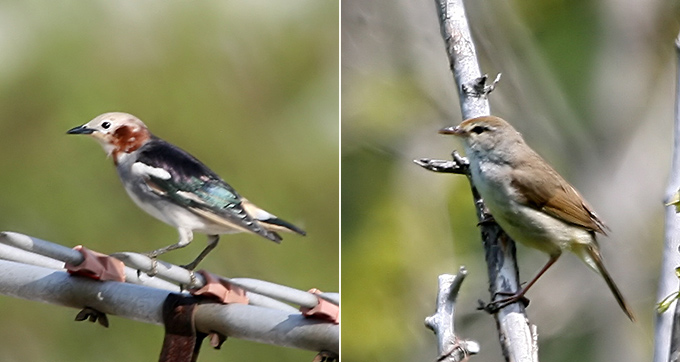
Photos © Mathew Poll
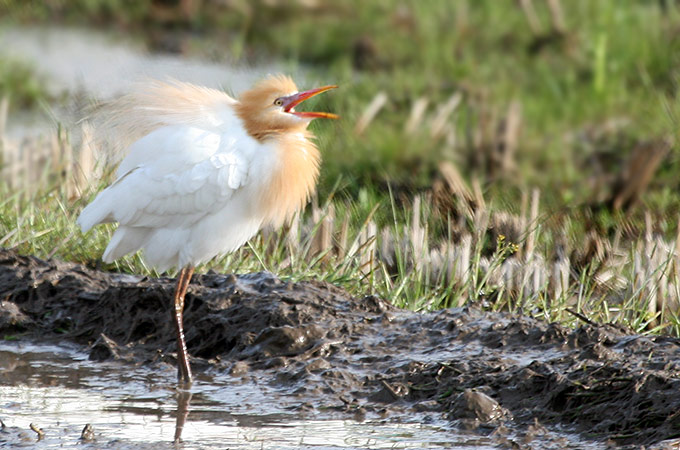
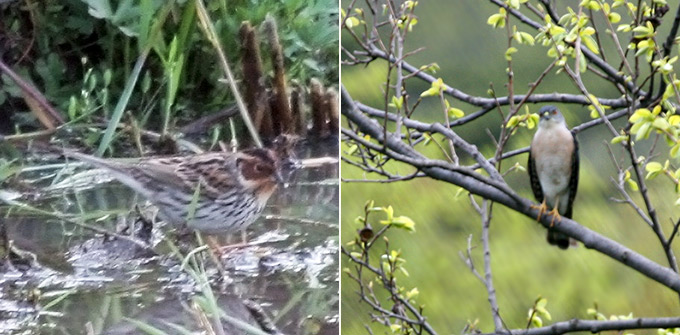
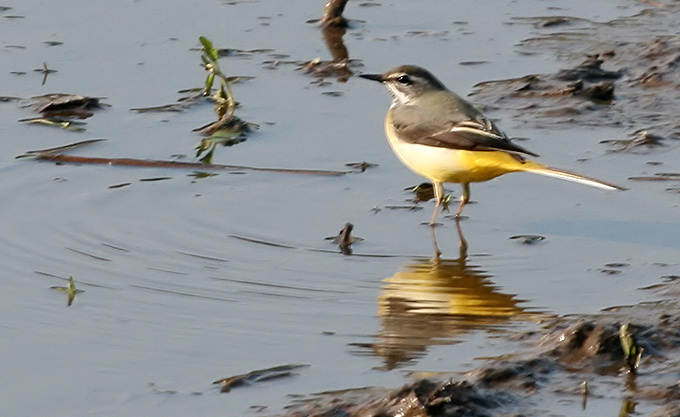
Eochong, May 1 - 4
Despite very sunny and warm conditions on the island, almost 100 species were logged. Buntings were well represented with 9 species (including Chestnut, Yellow-browed, Tristram's, Japanese Yellow, Yellow-breasted and Chestnut-eared), as were Thrushes with 7 species of Turdus (including Grey-backed, Scaly, Eye-browed, Brown-headed and Grey). Flycatchers were present in greatest numbers on the 3rd, with particularly good numbers of Blue-and-White, Yellow-rumped and Asian Brown, along with Narcissus, a single Mugimaki and small numbers of Grey-spotted. The Citrine Wagtail and baicalensis White-wagtail were present only until the 2nd.
Birds recorded in the garden areas included a few Chinese Grosbeak, 2 Siberian Blue Robin, 1 Rubythroat, 1 female Common Rosefinch and Japanese White-eye among other commoner species.
Around the reservoir and surrounding hills Warblers were reasonably well represented with plentiful Eastern Crowned as well as Yellow-browed, Dusky, Pale-legged and the diminutive Asian Stubtail. On the 2nd they were joined by a few Oriental Reed Warblers. Also arriving on the 2nd were the first Ashy Minivets, a few Dollarbirds, Violet-backed (Chestnut-cheeked) Starling and small numbers of Chinese Sparrowhawk.
New arrivals on the 3rd included an Eastern Oystercatcher, a single Mandarin Duck (looking quite lost in the harbour), 2 Black-capped Kingfishers and a White-breasted Waterhen. The latter species watched through the scope while 2 Yellow-rumped Flycatchers and a Blue-and-White Flycatcher bathed in the small stream in the foreground. The weather on this day was very warm and dry and many species were watched bathing in the small, shaded stream at the head of the reservoir.
Other species recorded on single occasions were Wigeon, Chinese Pond Heron, Green Sandpiper and Rufous-tailed Robin.
In the harbour area, Red-throated Pipit were present on all days and were joined on the 3rd by 3 Yellow Wagtail (with one taivana) and a Grey-tailed Tattler. On both night excursions Oriental Scops Owl was heard.
On the return ferry to Gunsan, a few Ancient Murrelet were seen, along with 4 distant, probable Red-throated Loon and a close Streaked Shearwater.
A very short stop at a mudflat within Saemangeum added some extra species to the trip list. A sizable roost of Great Knot, a handful of Dunlin as well as smaller numbers of Mongolian Plover, Terek Sandpiper and others. 1 impressive Chinese Egret stood in the shallows nearby.

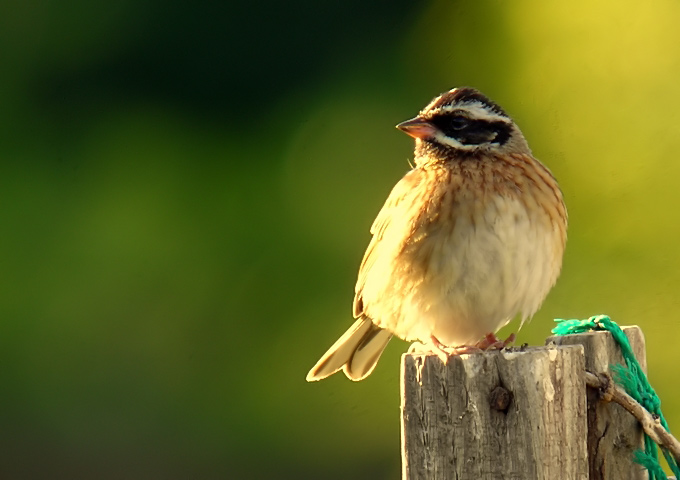

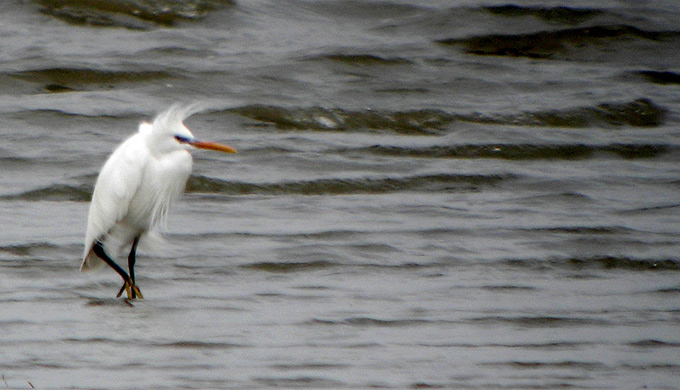
Song Do, May 3
Six counters covered this hugely fragmented and highly threatened site, once massive and inaccessible, now consisting of patches of relict tidal-flat in a landscape of reclamation rectangles, unfinished bridges and towering blocks.
Despite the hugely depressing landscape, over 9,200 shorebirds were counted at the northern tidal-flat (with the vast majority Dunlin: 8,300), and 18,200 at the southern tidal-flat, with most numerous Great Knot (8,000), Dunlin (6,500), Bar-tailed Godwit (1,000), Red-necked Stint (740), Grey Plover (730) and Mongolian Plover (470), as well as 11 Nordmann's Greenshank. In addition, 104 Saunders's Gull, 2 Chinese Egret and a total of 19 Black-faced Spoonbill were recorded at the count sites, and a small breeding colony of Mongolian Gull was discovered (with at least 5 active nests). Other species of note included single Black-winged Stilt and Long-toed Stint, though there was no sign of the Pied Avocet seen there on May 2nd.
Yeongjong-do, Ilsan, May 1
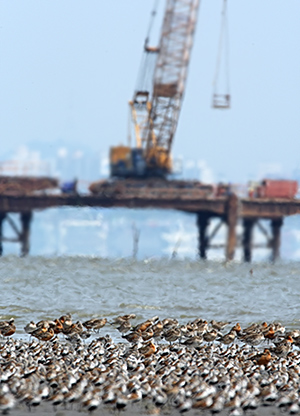
Amid a day of new international arrivals joining the SSMP team, the Birds Korea Natoinal Shorebird Survery team did some site assessment of Yeongjong-do ahead of their West and South coast survey. The survey will run from May 3rd to May 16th, and will supplement the previous National Shorebird Surveys conducted in 1988 and 1998.
A tight flock of 10,000 Dunlin was counted at the 13:35 high tide, along with 460 Bar-tailed Godwit 204 Whimbrel and 104 Great Knot. They were joined by 91 Far Eastern Curlew, 73 Grey Plover, 32 Common Greenshank, and 2 each of Sharp-tailed Sandpiper, Black-winged Stilt, Spotted Redshank and Kentish Plover. Singles of Red-necked Stint, Ruddy Turnstone and Mongolian Plover added to the diversity.
25 Saunders' Gulls were feeding actively throughout the count, while one Black-faced Spoonbill roosted and one Glaucous Gull was found amid a flock of gulls. The flock also held 13 leg-flagged birds, including 4 North west Australian Great Knot with engravings on their flags, and one Bar-tailed Godwit with black/green flags, denoting Thailand. Site assessment will take place over the next two days ahead of major counts starting on the 4th.


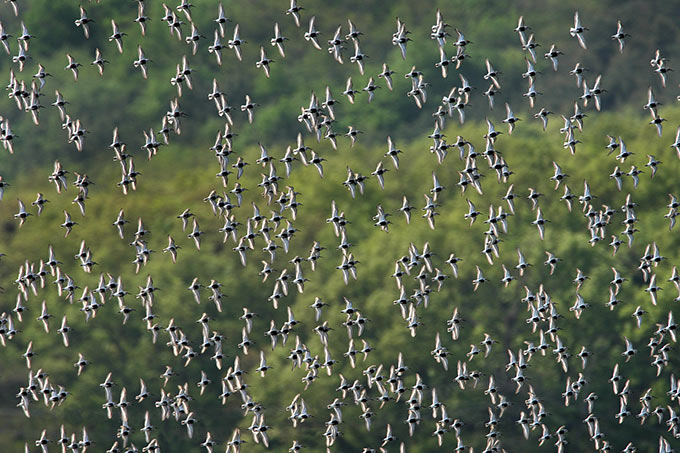
Jeongbalsan, Ilsan, May 1
I have been taking advantage of long lunch breaks and great weather to observe a steady trickle of great migrants and visitors on a quiet area of Jeongbalsan this week. There is a great mix of grass, reeds, scrub, forest edges, drainage ditches, and a variety of trees in this area. Many of the birds were only observed on one day only.
May 1
At least a dozen Asian Brown Flycatchers called high in the treetops. Startling to watch was a female Common Kestrel in the process of making a kill – it appeared to be a passerine with some yellow plumage, perhaps a Black-faced Bunting. A pair of mating Grey-headed Woodpeckers was seen, and many others were heard calling noisily in the forest. Many vocal and active Common Pheasant were seen and heard at the forest’s edge. A mystery Owl was seen perched in a tree. Highlight for the day was an unmistakable male Siberian Thrush, seen briefly skulking at the forest’s edge.
